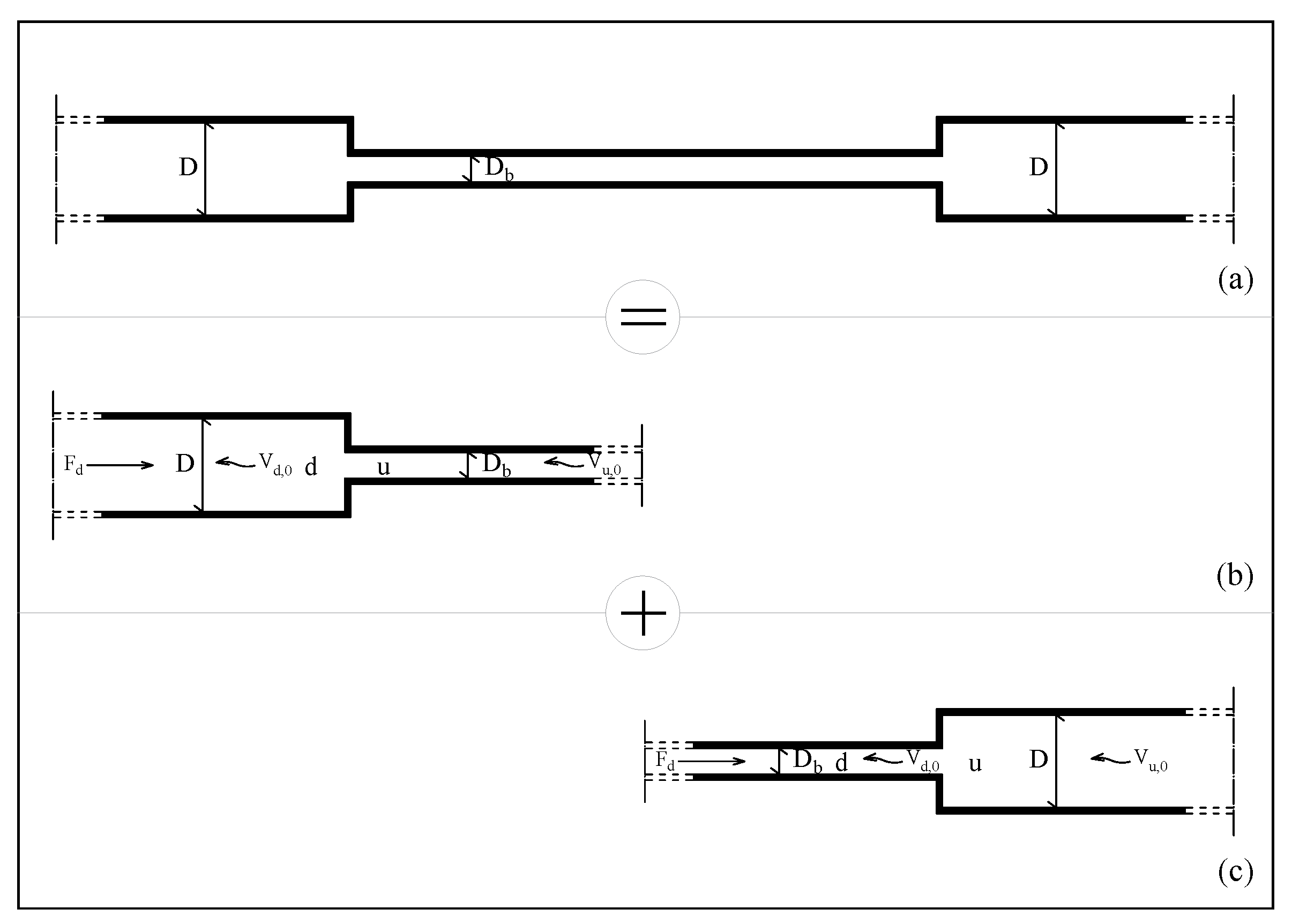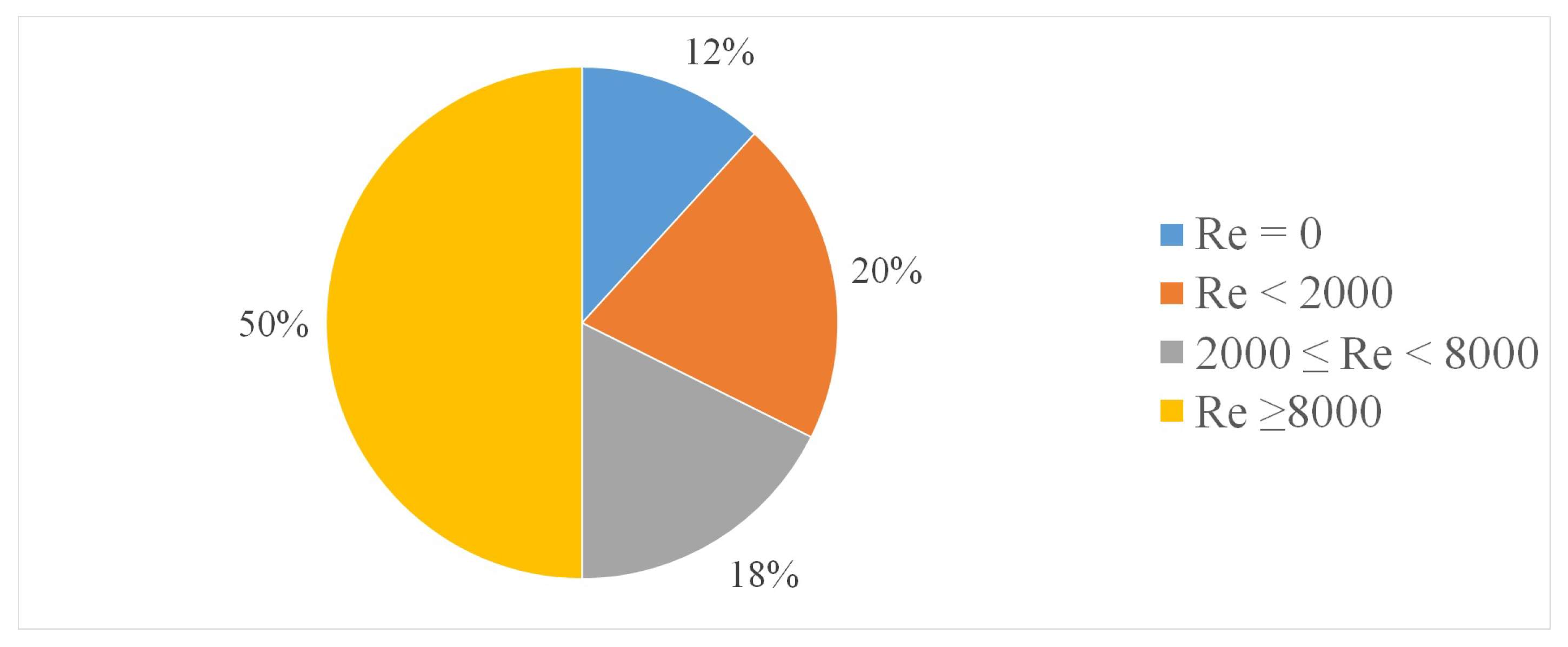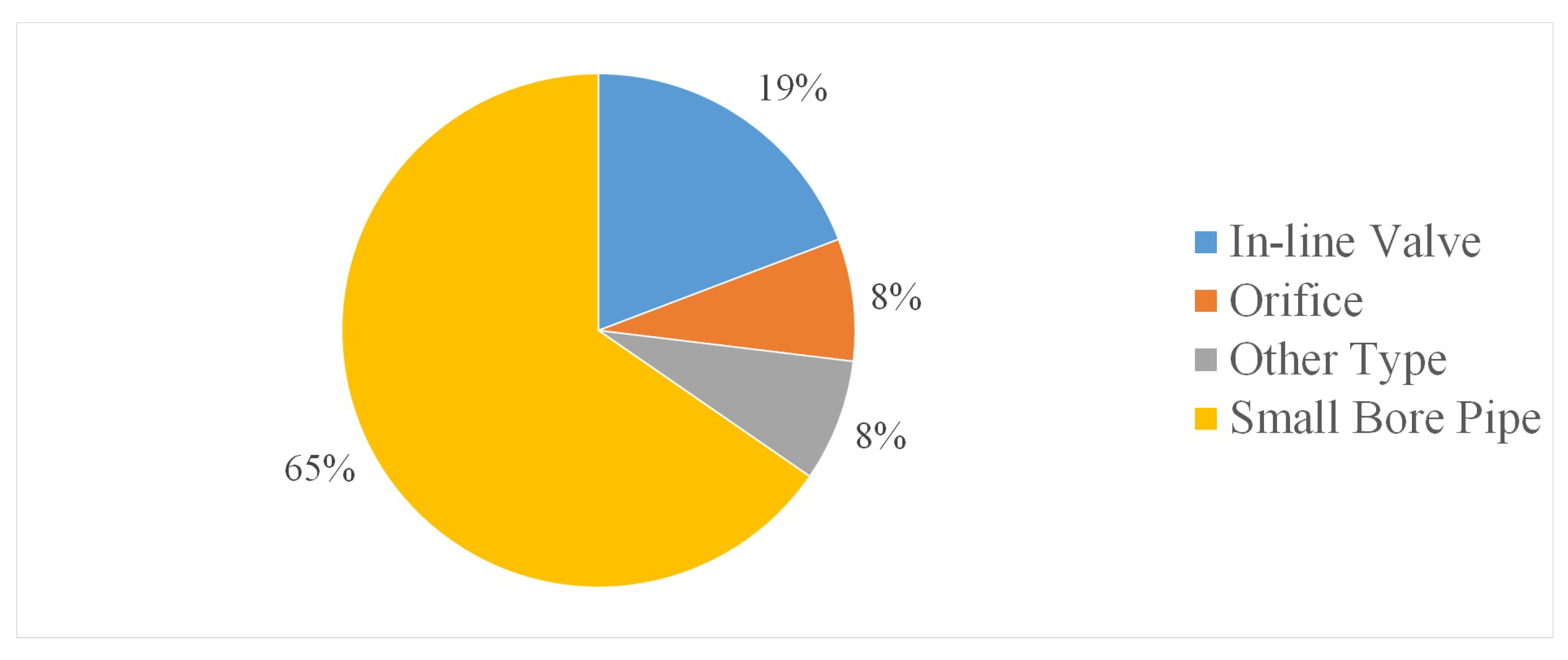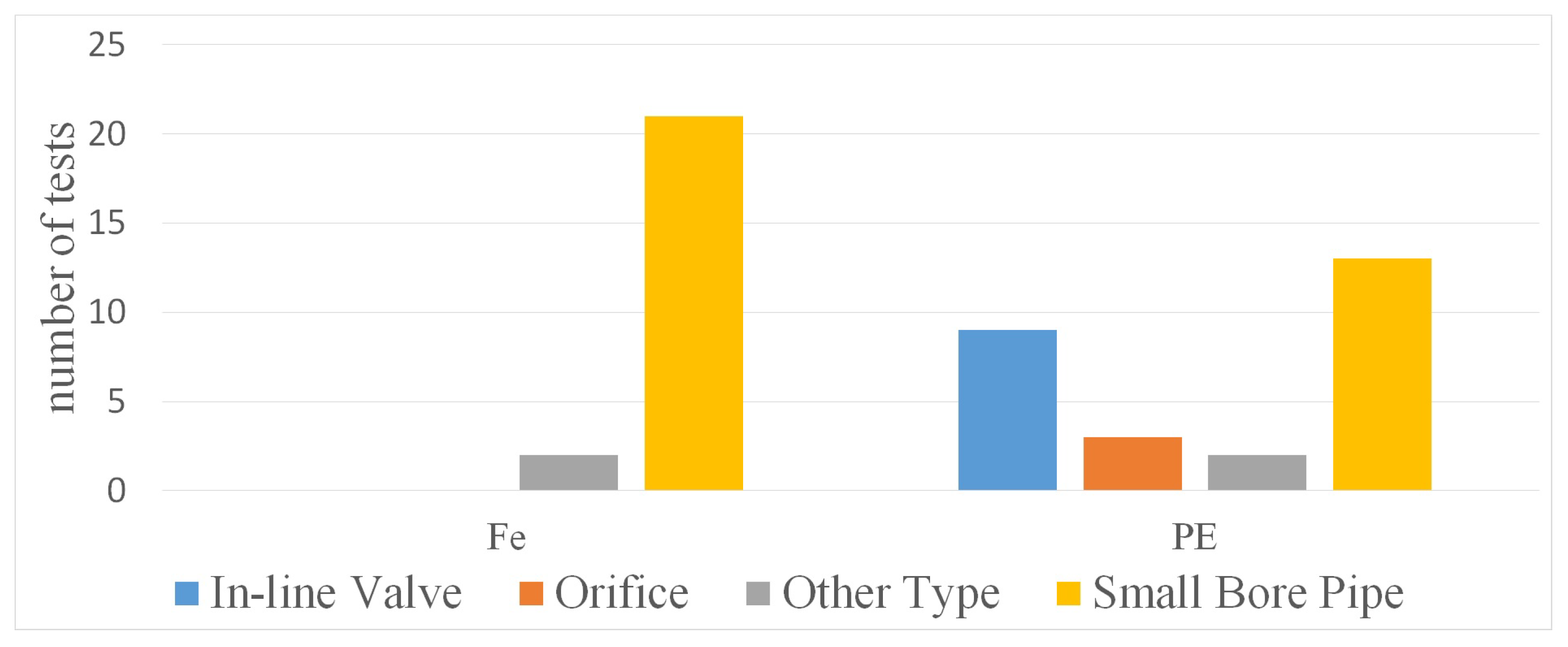Detection of Partial Blockages in Pressurized Pipes by Transient Tests: A Review of the Physical Experiments
Abstract
:1. Introduction
- conference papers, research reports, and PhD theses (in most cases, they include preliminary results with the complete series of data published in successive Journal papers);
- tests where the PB was due to an air pocket (then only experiments on “rigid” PBs are considered);
- papers where incomplete information was provided about the experimental layout, modality of transient generation, or PB simulation.
2. Mechanisms of Interaction between a Pressure Wave and a Partial Blockage (PB)
3. Categories of Physical Experiments
3.1. Category #1: Complexity of Layout and Modality of Transient Generation (CLM)
3.2. Category #2: Pipe Material
3.3. Category #3: Pipe Diameter
3.4. Category #4: Pre-Transient Pressure and Flow Regime
3.5. Category #5: Inserted Pressure Wave
3.6. Category #6: Blockage Simulation
4. Conclusions
Author Contributions
Funding
Data Availability Statement
Conflicts of Interest
Abbreviations
| a | pipe pressure wave speed |
| A | pipe cross-section area |
| PB pressure wave speed (for small-bore pipes only) | |
| cross-sectional area of the PB | |
| PB size | |
| D | pipe diameter |
| h | pressure head |
| length of the PB (for small-bore pipes only) | |
| partial blockage | |
| Reynolds number | |
| V | mean flow velocity |
| inserted pressure wave | |
| PB characteristic time (for small-bore pipes only) | |
| local head loss | |
| kinematic viscosity |
References
- Alnaimat, F.; Ziauddin, M. Wax deposition and prediction in petroleum pipelines. J. Pet. Sci. Eng. 2020, 184, 106385. [Google Scholar] [CrossRef]
- Duan, W.; Kirby, R.; Prisutova, J.; Horoshenkov, K.V. On the use of power reflection ratio and phase change to determine the geometry of a blockage in a pipe. Appl. Acoust. 2015, 87, 190–197. [Google Scholar] [CrossRef] [Green Version]
- Lile, N.L.T.; Jaafar, M.H.M.; Roslan, M.R.; Azmi, M.S.M. Blockage detection in circular pipe using vibration analysis. Int. J. Adv. Sci. Eng. Inf. Technol. 2012, 2, 54–57. [Google Scholar] [CrossRef] [Green Version]
- Papadopoulou, K.A.; Shamout, M.N.; Lennox, B.; Mackay, D.; Taylor, A.R.; Turner, J.T.; Wang, X. An evaluation of acoustic reflectometry for leakage and blockage detection. Proc. Inst. Mech. Eng. Part C J. Mech. Eng. Sci. 2008, 222, 959–966. [Google Scholar] [CrossRef]
- Yang, L.; Fu, H.; Liang, H.; Wang, Y.; Han, G.; Ling, K. Detection of pipeline blockage using lab experiment and computational fluid dynamic simulation. J. Pet. Sci. Eng. 2019, 183, 106421. [Google Scholar] [CrossRef]
- Meniconi, S.; Brunone, B.; Ferrante, M. In-line pipe device checking by short-period analysis of transient tests. J. Hydraul. Eng. 2011, 137, 713–722. [Google Scholar] [CrossRef]
- Duan, H.F.; Lee, P.J.; Ghidaoui, M.S.; Tuck, J. Transient wave-blockage interaction and extended blockage detection in elastic water pipelines. J. Fluids Struct. 2014, 46, 2–16. [Google Scholar] [CrossRef] [Green Version]
- Louati, M.; Meniconi, S.; Ghidaoui, M.S.; Brunone, B. Experimental study of the eigenfrequency shift mechanism in a blocked pipe system. J. Hydraul. Eng. 2017, 143, 04017044. [Google Scholar] [CrossRef] [Green Version]
- Brunone, B.; Maietta, F.; Capponi, C.; Keramat, A.; Meniconi, S. A review of physical experiments for leak detection in water pipes through transient tests for addressing future research. J. Hydraul. Res. 2022, 60, 894–906. [Google Scholar] [CrossRef]
- Contractor, D.N. The reflection of waterhammer pressure waves from minor losses. J. Basic Eng. 1965, 87, 445–451. [Google Scholar] [CrossRef]
- Duan, H.F.; Lee, P.J.; Kashima, A.; Lu, J.; Ghidaoui, M.S.; Tung, Y.K. Extended blockage detection in pipes using the system frequency response: Analytical analysis and experimental verification. J. Hydraul. Eng. 2013, 139, 763–771. [Google Scholar] [CrossRef]
- Duan, H.; Lee, P.; Che, T.; Ghidaoui, M.; Karney, B.; Kolyshkin, A. The influence of non-uniform blockages on transient wave behavior and blockage detection in pressurized water pipelines. J. Hydro-Environ. Res. 2017, 17, 1–7. [Google Scholar] [CrossRef]
- Lee, P.J.; Duan, H.F.; Tuck, J.; Ghidaoui, M. Numerical and experimental study on the effect of signal bandwidth on pipe assessment using fluid transients. J. Hydraul. Eng. 2015, 141, 04014074. [Google Scholar] [CrossRef]
- Massari, C.; Yeh, T.C.; Ferrante, M.; Brunone, B.; Meniconi, S. A stochastic approach for extended partial blockage detection in viscoelastic pipelines: Numerical and laboratory experiments. J. Water Supply Res. Technol. 2015, 64, 583–595. [Google Scholar] [CrossRef]
- Meniconi, S.; Brunone, B.; Ferrante, M.; Massari, C. Potential of transient tests to diagnose real supply pipe systems: What can be done with a single extemporary test. J. Water Resour. Plan. Manag. 2011, 137, 238–241. [Google Scholar] [CrossRef]
- Meniconi, S.; Brunone, B.; Ferrante, M.; Massari, C. Small amplitude sharp pressure waves to diagnose pipe systems. Water Resour. Manag. 2011, 25, 79–96. [Google Scholar] [CrossRef]
- Meniconi, S.; Brunone, B.; Ferrante, M. Water-hammer pressure waves interaction at cross-section changes in series in viscoelastic pipes. J. Fluids Struct. 2012, 33, 44–58. [Google Scholar] [CrossRef]
- Meniconi, S.; Duan, H.F.; Lee, P.J.; Brunone, B.; Ghidaoui, M.S.; Ferrante, M. Experimental investigation of coupled frequency and time-domain transient test–based techniques for partial blockage detection in pipelines. J. Hydraul. Eng. 2013, 139, 1033–1040. [Google Scholar] [CrossRef]
- Meniconi, S.; Brunone, B.; Ferrante, M.; Capponi, C. Mechanism of interaction of pressure waves at a discrete partial blockage. J. Fluids Struct. 2016, 62, 33–45. [Google Scholar] [CrossRef]
- Sattar, A.M.; Chaudhry, M.H.; Kassem, A.A. Partial blockage detection in pipelines by frequency response method. J. Hydraul. Eng. 2008, 134, 76–89. [Google Scholar] [CrossRef]
- Sun, J.; Wang, R.; Duan, H.F. Multiple-fault detection in water pipelines using transient-based time-frequency analysis. J. Hydroinform. 2016, 18, 975–989. [Google Scholar] [CrossRef] [Green Version]
- Tuck, J.; Lee, P. Inverse transient analysis for classification of wall thickness variations in pipelines. Sensors 2013, 13, 17057–17066. [Google Scholar] [CrossRef] [Green Version]
- Tuck, J.; Lee, P.J.; Davidson, M.; Ghidaoui, M.S. Analysis of transient signals in simple pipeline systems with an extended blockage. J. Hydraul. Res. 2013, 51, 623–633. [Google Scholar] [CrossRef]
- Wang, X.J.; Lambert, M.F.; Simpson, A.R. Detection and location of a partial blockage in a pipeline using damping of fluid transients. J. Water Resour. Plan. Manag. 2005, 131, 244–249. [Google Scholar] [CrossRef]
- Zouari, F.; Louati, M.; Meniconi, S.; Blåsten, E.; Ghidaoui, M.S.; Brunone, B. Experimental verification of the accuracy and robustness of area reconstruction method for pressurized water pipe system. J. Hydraul. Eng. 2020, 146, 04020004. [Google Scholar] [CrossRef]
- Wylie, E.B.; Streeter, V.L. Fluid Transients in Systems; Prentice Hall: Englewood Cliffs, NJ, USA, 1993. [Google Scholar]
- Swaffield, J.A.; Boldy, A.P. Pressure Surge in Pipe and Duct Systems; Ashgate Pub.: Farnham, UK, 1993. [Google Scholar]
- Pezzinga, G.; Brunone, B.; Cannizzaro, D.; Ferrante, M.; Meniconi, S.; Berni, A. Two-dimensional features of viscoelastic models of pipe transients. J. Hydraul. Eng. 2014, 140, 0401403. [Google Scholar] [CrossRef]
- Ayed, L.; Hafsi, Z.; Elaoud, S.; Meniconi, S.; Brunone, B. A transient based analysis of a leak in a junction of a series pipes system: Mathematical development and numerical modelling. J. Pipeline Syst. Eng. Pract. 2023. forthcoming. [Google Scholar] [CrossRef]
- Brunone, B.; Capponi, C.; Meniconi, S. Design criteria and performance analysis of a smart portable device for leak detection in water transmission mains. Measurement 2021, 183, 109844. [Google Scholar] [CrossRef]
- Martins, N.M.C.; Covas, D.I.C.; Meniconi, S.; Capponi, C.; Brunone, B. Characterization of low-Reynolds number flow through an orifice: CFD results vs. laboratory data. J. Hydroinform. 2021, 23, 709–723. [Google Scholar] [CrossRef]
- Brunone, B.; Ferrante, M.; Meniconi, S. Discussion of “Detection of partial blockage in single pipelines” by P. K. Mohapatra, M. H. Chaudhry, A. A. Kassem, and J. Moloo. J. Hydraul. Eng. 2008, 134, 872–874. [Google Scholar] [CrossRef]
- Meniconi, S.; Maietta, F.; Alvisi, S.; Capponi, C.; Marsili, V.; Franchini, M.; Brunone, B. Consumption change-induced transients in a water distribution network: Laboratory tests in a looped system. Water Resour. Res. 2022, 58, e2021WR031343. [Google Scholar] [CrossRef]











| Category (#) | Title |
|---|---|
| 1 | complexity of the test system and modality of transient generation |
| 2 | pipe material |
| 3 | pipe diameter |
| 4 | pre-transient pressure and flow regime |
| 5 | inserted pressure wave |
| 6 | partial blockage simulation |
| Paper Number | TLM | Mat. | D | h | Re | h | Type | Size | ||
|---|---|---|---|---|---|---|---|---|---|---|
| [10] | L, SP, VC | - | - | , | , | , | O | - | - | - |
| [11] | L, SP, VC | Fe | - | , | - | SBP | from 6.06 to 12.07 | - | ||
| [12] | L, SP, VC | Fe | - | , | - | SBP | 5.59 | 0.0085 | ||
| L, SP, VC | Fe | - | , | - | OT | 5.54, 5.59 | 0.0106, 0.0110 | |||
| [13] | L, SP, VC | Fe | - | - | SBP | 12.248 | 0.0181 | |||
| [8] | L, SP, PPWM | PE | SBP | 3.6, 24 | 0.0185, 0.1234 | |||||
| [14] | L, SP, VC | PE | SBP | 3.56 | 0.0180 | |||||
| [6] | L, SP, VC | PE | , | IV | - | - | ||||
| L, SP, VC | PE | O | - | - | ||||||
| [15] | F, BS, VC | Fe | IV | - | - | - | ||||
| [16] | L, SP, PPWM | PE | SBP | 7.06 | 0.036 | |||||
| L, SP, PPWM | PE | IV | - | - | - | |||||
| [17] | L, SP, VC | PE | SBP | from 0.06 to 100 | from 0.0003 to 0.5141 | |||||
| [18] | L, SP, VC | Fe | - | SBP | from 6.06 to 12.07 | from 0.088 to 0.0176 | ||||
| [19] | L, SP, VC | PE | , | IV | - | - | ||||
| L, SP, VC | PE | , | SBP | 0.48 | 0.0025 | |||||
| L, SP, VC | PE | , | OT | 0.12, 0.48 | 0.0006, 0.0025 | |||||
| [20] | L, SP, OM | Cu | - | - | - | - | - | |||
| [21] | L, SP, VC | Fe | , | SBP | 5 | - | ||||
| [22] | L, SP, VC | Fe | SBP | 10.407 | 0.0158 | |||||
| [23] | L, SP, VC | Fe | - | , | - | SBP | , | from 2.866 to 12.068 | from 0.0045 to 0.0176 | |
| [24] | L, SP, VC | - | - | - | IV | - | - | - | ||
| [25] | L, SP, PPWM | PE | , | SBP | , | 24 | 0.1206, 0.1234 | |||
| L, SP, VC | PE | SBP | , | 24 | 0.1206, 0.1234 |
| Category #1: complexity of layout and modality of transient generation (CLM) | |
|---|---|
| Complexity of the functioning conditions | Symbol |
| Laboratory tests | L |
| Field tests | F |
| Complexity of the test system | Symbol |
| Single pipes | |
| Branched systems | |
| Modality of transient generation | Symbol |
| Valve closure | |
| Portable Pressure Wave Maker or Other Maneuver | |
| Category #2: material (Mat.) | |
| Type | Symbol |
| Steel-Cast iron | |
| Copper | |
| Polyethylene | |
| Category #3: pipe diameter (D) | |
| Symbol | Range [mm] |
| 20 ≤ D < 50 | |
| 50 ≤ D < 100 | |
| D≥ 100 | |
| Category #4: pre-transient pressure (h) and flow regime (Reynolds number, ) | |
| Symbol | Range [m] |
| h < 20 | |
| 20 ≤ h < 50 | |
| h ≥ 50 | |
| = 0 | |
| < 2000 | |
| 2000 ≤ < 8000 | |
| ≥ 8000 | |
| Category #5: inserted pressure wave () | |
| Symbol | Range [m] |
| 5 | |
| 5 ≤ 10 | |
| 10 ≤ 20 | |
| 20 ≤ 50 | |
| 50 | |
| Category #6: partial blockage simulation | |
| Partial blockage type | |
| Type | Symbol |
| In-line Valve | |
| Orifice | O |
| Other type | |
| Small Bore Pipe | |
| Partial blockage size | |
| Symbol | Range [%] |
| B < 25 | |
| 25 ≤ B < 50 | |
| 50 ≤ B < 75 | |
| B ≥ 75 | |
| Partial blockage extension (only for SBP and OT) | |
| Length, [m] | |
| Characteristic time, [s] | |
Disclaimer/Publisher’s Note: The statements, opinions and data contained in all publications are solely those of the individual author(s) and contributor(s) and not of MDPI and/or the editor(s). MDPI and/or the editor(s) disclaim responsibility for any injury to people or property resulting from any ideas, methods, instructions or products referred to in the content. |
© 2023 by the authors. Licensee MDPI, Basel, Switzerland. This article is an open access article distributed under the terms and conditions of the Creative Commons Attribution (CC BY) license (https://creativecommons.org/licenses/by/4.0/).
Share and Cite
Brunone, B.; Maietta, F.; Capponi, C.; Duan, H.-F.; Meniconi, S. Detection of Partial Blockages in Pressurized Pipes by Transient Tests: A Review of the Physical Experiments. Fluids 2023, 8, 19. https://doi.org/10.3390/fluids8010019
Brunone B, Maietta F, Capponi C, Duan H-F, Meniconi S. Detection of Partial Blockages in Pressurized Pipes by Transient Tests: A Review of the Physical Experiments. Fluids. 2023; 8(1):19. https://doi.org/10.3390/fluids8010019
Chicago/Turabian StyleBrunone, Bruno, Filomena Maietta, Caterina Capponi, Huan-Feng Duan, and Silvia Meniconi. 2023. "Detection of Partial Blockages in Pressurized Pipes by Transient Tests: A Review of the Physical Experiments" Fluids 8, no. 1: 19. https://doi.org/10.3390/fluids8010019





